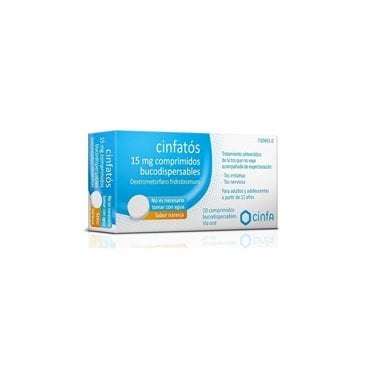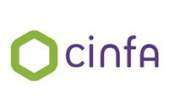Cinfatos 15 Mg 20 Orodispersible Tablets (Pvc-Pvdc/Al)
Cinfatos 15 Mg 20 Orodispersible Tablets is indicated for the symptomatic treatment of cough that is not accompanied by expectoration (irritative cough, nervous cough) for adults and adolescents from 12 years of age.
Cinfatos 15 Mg 20 Orodispersible Tablets is indicated for the symptomatic treatment of cough that is not accompanied by expectoration (irritative cough, nervous cough) for adults and adolescents from 12 years of age.
Cinfatos (15 Mg 20 Orodispersible Tablets (Pvc-Pvdc/Al))
ACTION AND MECHANISM
- Antitussive. Dextromethorphan is a derivative of 3-methoxy-levorphanol, an opiate alkaloid analogue of codeine, which acts at the cough center, depressing it. Although their exact mechanism of action is unknown, opiates could act by inhibiting the production of tachykinins, the main neurotransmitters of C fibers, which constitute said control center.
It has an antitussive effect similar to codeine, but lacks narcotic or respiratory center depressant effects.
PHARMACOKINETICS
- Absorption: rapid absorption, with cmax of 5.2-5.8 ng/ml and tmax of 2 h after a 60 mg dose. Its effects appear in 15-30 minutes and last for 6 hours. Its bioavailability is reduced due to an intense hepatic first-pass effect.
Food effect: do not affect the pharmacokinetics of dextromethorphan.
- Distribution: its Vd is 7.3 l.
- Metabolism: extensive and rapid in the liver by CYP2D6 and CYP3A4, giving rise to several demethylated metabolites. The majority is dextrorphan, partially active, and to a lesser extent 3-methoxy and 3-hydroxy-morphinan, both inactive.
Enzyme inducing/inhibitory capacity: no data available.
- Elimination: in urine (20-86% in 48 hours), in the form of free or conjugated metabolites. Minimal amounts in feces (< 1%). Its t1/2 is 1.4-3.9 h (dextromethorphan) and 3.4-5.6 h (dextrorphan).
Pharmacokinetics in special situations:
- Genetic polymorphism: dextromethorphan is a substrate of CYP2D6, a cytochrome P450 isoenzyme of which populations with non-functional alleles have been described, which act as slow metabolizers (up to 6% of the population). These patients could see dextromethorphan elimination reduced, with cmax and AUC up to 16 and 150 times higher respectively and t1/2 prolonged up to 45 h.
- Other situations: there are no specific data in children, the elderly or patients with kidney or liver failure. However, an increase in its t1/2 is to be expected in patients with liver failure.
INDICATIONS
- Symptomatic treatment of impoductive [DRY COUGH], such as irritative cough or nervous cough.
POSOLOGY
- Adults: 15 mg/4 h or 30 mg/6-8 h. Maximum dose 120 mg/24 h.
- Children and adolescents < 18 years:
* Adolescents from 12 years old: same as adults.
* Children 6-11 years old: 15 mg/6-8 h. Maximum dose 60 mg/24 h.
* Children < 6 years: not adapted to this age.
- Elderly: no dosage adjustment required.
Duration of treatment: it is recommended to use it for the minimum possible time to control the symptoms. If symptoms continue or worsen after 7 days, or if they are accompanied by high fever, skin rashes or persistent headache, consult a doctor and/or pharmacist.
Forgotten dose: administer the next dose at the usual time. Do not double the next dose.
DOSAGE IN KIDNEY FAILURE
No specific dosage recommendations have been made. Use with caution.
DOSAGE IN LIVER FAILURE
No specific dosage recommendations have been made. Use with caution.
RULES FOR CORRECT ADMINISTRATION
Administration with food: can be taken with or without food. Avoid grapefruit or bitter orange juice.
- Orodispersible tablets: place the tablet in the mouth, allow it to disperse with saliva, and swallow. It is not necessary to ingest water at the time of intake.
ADVICE TO THE PATIENT
- Drink plenty of water during treatment.
- Do not take dextromethorphan if you have been treated with antidepressants in the previous 14 days. Consult your doctor and/or pharmacist.
- Tell your doctor and/or pharmacist if you develop symptoms such as persistent cough for more than 7 days despite treatment, or if it is accompanied by severe headache, fever or skin rash.
CONTRAINDICATIONS
- Hypersensitivity to dextromethorphan, [OPIOID ALLERGY] or any other component of the medication.
- Serious respiratory pathologies such as [ASTHMA], [PRODUCTIVE COUGH], [CHRONIC OBSTRUCTIVE LUNG DISEASE], [PNEUMONIA], [RESPIRATORY FAILURE] or [RESPIRATORY DEPRESSION].
- Children < 2 years (see Children).
- Treatment with MAOIs, SSRIs, bupropion, linezolid, procarbazine or selegiline in the previous 2 weeks (see Interactions; enzyme inhibitors).
- Breastfeeding (see Breastfeeding).
PRECAUTIONS
- Cough. It should not be used in case of chronic cough or cough due to smoking, as it can impair expectoration and increase airway resistance.
- Atopic processes. It could worsen the symptoms of diseases such as [ATOPIC DERMATITIS] or [MASTOCYTOSIS] due to the increase in the release of histamine.
- [DRUG DEPENDENCE]. Dextromethorphan can potentially give rise to dependence phenomena (cases of abuse have been described in adolescents, sometimes resulting in fatal poisoning), although to a much lesser extent than other opioids such as morphine. It is recommended to take extreme precautions and monitor the patient, especially people with a history of drug addiction, in case symptoms of abuse appear, such as mood changes, modification of the person's habits or appearance, abuse of large quantities of products. for cough or disappearance of medicines from the home medicine cabinet.
- Neurological diseases. Assess the benefit/risk relationship in patients with neurological disorders associated with a decreased cough reflex, such as [STROKE], [DEMENTIA] or [PARKINSON'S DISEASE].
- Slow metabolizers. Dextromethorphan is a CYP2D6 substrate. Around 10% of the general population is a slow metabolizer of this isoenzyme, with a risk of dextromethorphan accumulation and toxicity. Lower doses of dextromethorphan may be required.
- Limitations in clinical experience. Its efficacy and safety have not been evaluated in patients with [KIDNEY FAILURE] or [LIVER FAILURE]. Use with caution, especially in seriously ill patients.
SPECIAL WARNINGS
- Monitor for possible symptoms of dextromethorphan abuse, such as changes in mood, changes in habits or appearance, or abuse of large amounts of cough products.
- Risk of serious interactions when combining antidepressants such as MAOIs or SSRIs, as well as drugs with MAOI activity such as linezolid.
INTERACTIONS
- Expectorants and mucolytics. Inhibition of the cough reflex could lead to pulmonary obstruction in the event of an increase in the volume or fluidity of bronchial secretions.
- Hypnotics. Risk of potentiation of the sedative effect when combined with alcohol or drugs such as barbiturates, benzodiazepines, H1 antihistamines, other opioid analgesics or antipsychotics.
- Enzyme inhibitors. Dextromethorphan is a CYP2D6 substrate, so its effects and toxicity could increase when combined with drugs such as abiraterone, antiarrhythmics (amiodarone, flecainide), bupropion, coxibes, imatinib or terbinafine. Reduce the dose of dextromethorphan if the combination is necessary.
Avoid drinking grapefruit or bitter orange juice, which can inhibit CYP2D6 and 3A4.
The association of dextromethorphan with certain CYP2D6 inhibitors such as MAOIs, drugs with MAOI activity (e.g. linezolid, procarbazine) or SSRIs (e.g. paroxetine) has been related to the development of severe serotonergic syndrome. The association is contraindicated, and these medications must be spaced out for at least 14 days.
Combine with caution with other serotonergic drugs such as tricyclic antidepressants.
- Memantine. Dextromethorphan could enhance the toxicity of memantine. Avoid association.
PREGNANCY
Safety in animals: no data available.
Safety in humans: There are no adequate and well-controlled studies in humans. The administration of dextromethorphan is only accepted if there are no safer therapeutic alternatives, and the benefits outweigh the possible risks.
Effects on fertility: no specific studies have been performed in humans.
LACTATION
Safety in animals: no data available.
Safety in humans: it is unknown if it is excreted with milk, and the consequences it could have for the infant. Is recomended to suspend the lactancy or evy the administration.
CHILDREN
Dextromethorphan could be used in children from 2 years of age, with corresponding dosage adjustments depending on age. It is recommended to select those presentations especially indicated in children between 2-12 years (see Dosage).
Children may be especially sensitive to the adverse effects of opioids.
Its use in < 2 years is contraindicated. Serious adverse reactions, some fatal, have been reported when using OTC flu medications in these children.
ADVANCED AGE
No specific dosage recommendations have been made.
EFFECTS ON DRIVING
Dextromethorphan does not appear to have significant central depressant effects, unlike other opiates. However, dizziness is common.
ADVERSE REACTIONS
Adverse reactions are described according to each frequency interval, being considered very common (>10%), common (1-10%), uncommon (0.1-1%), rare (0.01-0.1%). , very rare (<0.01%) or of unknown frequency (cannot be estimated from the available data).
- Immune system disorders: frequency unknown [HYPERSENSITIVITY REACTIONS] including [ANAPHYLAXIA], [ANGIOEDEMA], [URTICARIA], [PRURITUS], rash and [ERYTHEMA].
- Psychiatric disorders: very rare [HALLUCINATIONS], [OPIACE DEPENDENCY].
- Nervous system disorders: common [DIZZY]; very rare [SOMNOLENCE]; unknown frequency [HEADACHE], [CONFUSION].
- Gastrointestinal disorders: frequent [NAUSEA], [VOMITING], and intestinal discomfort; unknown frequency [CONSTIPATION].
- Skin and subcutaneous tissue disorders: frequency unknown [DRUG ERUPTION].
- General disorders and alterations at the administration site: common [FATIGUE].
OVERDOSE
Symptoms: adverse reactions are usually especially important in children and adolescents or in cases of abuse. Among the symptoms described are nausea, vomiting and gastrointestinal disorders, dizziness, fatigue, drowsiness, hallucinations, restlessness and excitability. In more severe cases, symptoms such as decreased concentration and consciousness up to coma, dysphoria and euphoria, psychotic disorders such as disorientation and delusions to states of confusion or paranoid, increased muscle tone, ataxia, dysarthria, nystagmus and visual disturbances may occur. , as well as respiratory depression, changes in blood pressure and tachycardia may occur.
Finally, there is a risk of serotonergic syndrome.
Measures to take:
- Antidote: in case of severe poisoning, the administration of naloxone (0.01 mg/kg in children) could be considered.
- General elimination measures: gastric lavage with aspiration, followed by the administration of activated charcoal.
- Monitoring: respiratory and cardiovascular functionality.
- Treatment: keep the airways open, establishing assisted breathing if necessary. symptomatic treatment.
Leaflet Cinfatos 15 Mg 20 Orodispersible Tablets (Pvc-Pvdc/Al)



